 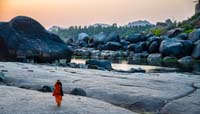      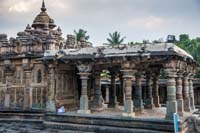    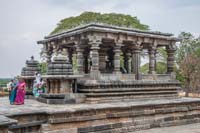  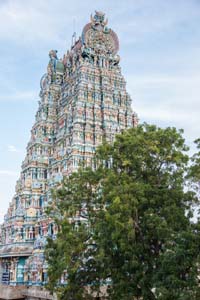 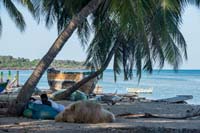 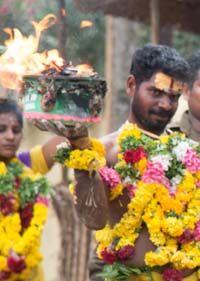 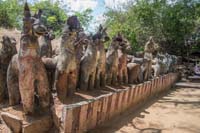  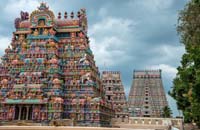 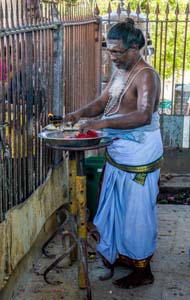 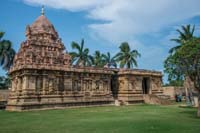  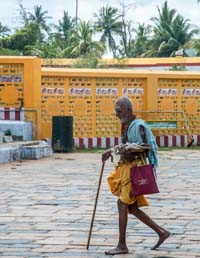 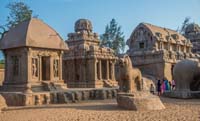  |
Dravidian Heritage Trail 18 Days from Chennai Day 1: Chennai You will probably have an early morning arrival. Rest a bit then join the locals for a stroll along the 8 mile long shoreline. Day 2: Chennai In the morning, you can set up a sightseeing tour of Chennai. Once known as Ft. St George, this is where the British East India trading Company got its start and it is still the commercial capital of Tamil Nadu. There’s plenty of Raj era sights to see from Fort George to the Railway station, but the highlight is bound to be the collection of 700 Chola Bronzes in the Pantheon Museum. In the afternoon, depart for the 1 hour drive to Mahabalipuram. Hotel: There are no heritage hotels here, but the Indeco Mahabalipuram was cute and within walking distance of town. Day 3: Mahabalipuram (Mamalapuram) Day excursion from Mahabalipuran to Kanchipuram and return to Mahabalipuram Kanchipuram, one of India’s seven sacred cities, is about a 1 1/2 hour drive west of Mahabalpuram. Besides being a major silk producing center, it is home to about 70 temples from the 4th C. Pallava Dynasty. There are 2 temples here that are very important. The Ekambaresvara Temple is famous for its Thousand Pillared Hall. It was built by the Pallavas and enhanced by the Cholas. The inner sanctum is open only to Hindus, but the carvings and the sacred mango tree are all worth seeing. The Kailasanatha Temple is the oldest temple in Kanchipuram, dating back to the Dravidian era and has good examples of carvings from that era. After sightseeing here, return for some sightseeing in Mahabalipuram. During the 7th century this was the Pallava dynasty’s seaport which launched Hinduism to the far corners of Southeast Asia. It’s easy to see the artistic similarities between the magnificent shore temples here and the temples in Vietnam and Indonesia. The Panch Ratha (“Five Chariots”) temples are eroded by wind and sea, but are still evocative and usually full of Hindu pilgrims. The 2006 tsunami even managed to uncover a couple of new little gems. Nearby is one of India’s most famous bas-relief carvings, Descent of the Ganges – also known as Arjuna’s Penance Day 4: Pudacherry Drive south for 3 hour drive south to Puducherry (a.k.a. Pondicherry) There’s not lot of “monument” type sightseeing here, but it’s a wonderful place to hang out. It was a French protectorate until 1954, still drips with old world charm. Walk along the beach and the French Quarter, or visit the Ganesh Temple (Sri Manakula Vinaayagar) If you want to visit the Sri Aurobindo Ashram, be sure to make arrangements in advance by going to their website. www.sriaurobindoashram.org They are set up for stays of a week or more, if there is space, they will allow you to stay for one night. Hotels: The most important thing in Pondecherry is to stay in the old French part of town. It’s green and pleasant with lots of cafes and cute craft shops. There is a wealth of charming heritage hotels. Talk to your tour operator, but the ones I know I liked in 2017 are: Les Hibiscus, but with only 4 rooms, it will be tough. www.leshibiscus.in, Hotel de l’Orient www.neemranahotels.com Le Dupliex www.leduliex.com L’Escale ( it has ocean views) www.lesalepondicherry.com and the Hotel Pondicherry which doesn’t seem to have a website but can be called at 91 0413 222-7409 Day 5: Pudacherry Relax in Pondicherry or perhaps take the ¾ day tour of Auroville and see some of their craft production. This attempt at a utopian lifestyle is fascinating to see and the veg lunch they serve is delicious. I wish I had known that one needed to sign up in advance to get inside the immense gold central temple called the Matrimandir. Day 6: Drive to Kumbakonam via Chidabaram Leave Pudacherry early for the 2 hour drive to the ancient Chola Dynasty capitol of Chidabaram, The piece de resistance here is the 6th century, gold plated roofed Shiva Nataraja Temple, but it closes from noon to 4:30PM. It’s a huge complex and will take a couple of hours to see it. Also, be forewarned – cameras are not allowed in the inner most courtyard. Vedic priests, descendants of the original caretakers from 3000 years ago, will show you around the five massive halls. Shiva performed his cosmic dance on site and the bronze Shiva Nataraja statue commemorating this is one of the highlights of Indian art. After lunch, continue west for another 2 ½ hours to the small town of Kumbakonam. There are 18 temples in this town. The Kumbesvara which is the largest one, and Nagesvara Swami which has a carved stone chariot drawn by horses are the most famous. There is also a nice Vishnu temple here – Sarangapani which is very beautiful. Hotel: Indeco Swamimalai. This is one of my all-time favorite heritage hotels. The owner bought an entire abandoned village and painstakingly restored it. The main building (with 4 rooms, which you might want to request) is a merchant’s home which was brought in from Chennai. The entire property is part museum, part hotel and he has taken great pains to employ the local townspeople. The only downside is that there is a new annex for groups so that the dinner and breakfast buffet were a bit chaotic. My feeling, however, was that the good far outweighed this minor inconvenience. Day 7: Drive from Chidabaram to Trichy via Tanjore All totaled, the distance from Kumbakoman to Thanjavur (a.k.a. Tanjore) is 65km, mostly along the beautiful Coromandal coast, but there are a couple of interesting stops along the way. Swamimali is home to the remaining bronze casting artisans who once made the famous Chola bronzes, renowned worldwide for their fine detail and exquisite workmanship. A little further on, is the huge granite temple of Gangaikonda Cholisvaram. Built in 1020AD, it is over 60 meters high and contains the largest Shiva lingams in South India. Thanjavur was the capital of the Chola Dynasty at its apogee. This was the most powerful South Indian kingdom and is responsible for spreading Hinduism and Indian culture into Asia. The Brihadisvara Temple – now a World Heritage Site – was built in 1000 AD and is one of the marvels of Hindu architecture. The main gopurum is over 70 meters and is covered with sculptures. The black granite Nandi Mandapa is one of the largest in India. Don’t leave without finding the brightly painted elephant who will take your donation out of your hand with his trunk. Continue on to Trichy. It should be only about a 2 hour drive to Srirangam, situated just north of Trichy. This is, perhaps, India’s largest temple complex, set on an island at the confluence of the Kaveri and Kolidam rivers, The Ranganathasvami Temple, dedicated to Vishnu, is one of the largest in India. The 21 carved and painted gopurumas and Thousand Pillared Hall (Ok, only 540, but who’s counting?) are magnificent. On the banks of the river, worshipers come to worship, bathe, cremate the dead. Even though non-Hindus are not allowed into the inner most sanctuary, there is plenty to see. After lunch, it’s only 5 miles down to Trichy. The town of Trichy itself, is pretty quiet. There is a rock fortress 270 up on a hill, if you fancy a climb. If not, there are 2 cave temples at the base of the hill. Hotel – There are no heritage hotels here. Day 8: Drive from Trichy to Chettinad. There’s a delightful little treat along the road to Chettinad! Over the years, people have lined up hundreds of clay horses at the Ayyanar temple. Be sure to stop off for a look – it’s absolutely charming. In the post WWl era, the merchants and bankers in this area became fabulously wealthy and built thousands of magnificent mansions. No expense was spared as massive amounts of teak, marble, and rosewood were put into the homes with countless inner pavilions. The best known is the Lakshmi House, famous for its carved wood ceilings. There are several small temples in town as well as many antique stores that sell the cast-offs from the mansions. The local cuisine here is famous – curries are served up on banana leaves Take the afternoon to explore several of them. Hotels: Some of the fabulous old mansions have been restored and turned into hotels. The most impressive is the Chidabaram Vilas www.chidabaramvilas.com but also consider the less expensive Chettinadu Mansion. www.chettinadumansion.com Day 9 – Drive to Rameswaram. The drive today will be about 4 hours as the road is quite rural. According to the Ramayana, The Rameswaran Temple is where Rama and Hanuman led their army into Sri Lanka to rescue Sita. Shiva stopped here after that battle to leave a lingam, which is the central relic in this temple. There are 5 gopuras, but the highlight is the corridor around the inner temple. It is made up of 1212 pillars, carved to resemble bulls holding up the beautiful painted ceiling. It is a pilgrimage site for both Hindus and Sikhs (Govind Singh came here) so it is always full of people and raucous happenings. Just be forewarned that no cameras, not even cell phones, are allowed in. Unfortunately, the fishing village that was on the causeway was pretty much destroyed in a 1964 cyclone so the road is closed a couple of km before it. Unless you hire a boat, there will be no seeing the temple and the boulders that constitute Adam’s Bridge that Hanuman used to get to Sri Lanka! N.B. I could have done without my excursion to Rameswaram in 2017, and if you chose to leave it out it will save a day off the trip. No causeway, and no cameras in the temple killed it for me. The town is horribly full of trash – even by Indian standards – and otherwise, there just wasn’t anything that interesting to see. There are no heritage hotels in Rameswaram. Day10: Drive to Madurai Drive the 4 hours back to Madurai where, even from outside town, you will see the 9 huge gopurums if the Meenaksi Temple. While the temple in Tanjore is the most important historically, this one is probably the mother-lode of South India temples. We will have the day tomorrow to go through the temple, so perhaps today you could get involved with all the colorful chaos that surrounds it. Thousands of Hindu pilgrims will be there. Street sellers hawk flowers, food, and religious items. The Gandhi Museum is housed in a 300 year old palace that is reason enough to visit it. . Return to the temple by 6PM for performances of live bhajan music. As the sun sets, a great procession inside the temple – brings a statue of Sundareshvara back into the inner sanctum to spend the night with Meenakshi. Cell phones are allowed inside the temple, but no regular cameras. Hotels – There are 2 nice heritage hotels in Madurai. The Gateway is a colonial era collection of buildings that sits on a hill overlooking the town. I thought it was a bit long in the tooth, but the setting was very nice. Request an upgraded room with a view if you are going to stay here. The Madurai Heritage hotel was magnificent, but set in the flatlands of town. An old Raj officer’s club, it has been elegantly restored, has a beautiful main swimming pool, fabulous suites with private plunge pools, and great service. Day 11: Madurai Dress very conservatively this morning (no shoulders or legs showing) and set off for the temple. This enormous temple is dedicated to Shiva (known here as Sundareshvara – the handsome God) and Meenakshi (The Fish Eyed Goddess, as Parvati is called) the 4 main gopurums and 8 lesser gopurums are covered with thousands of stucco figures. The whole thing is painted once every 12 years (last time in 2009) so it fades from brightly colored to more subtle. It will take you the better part of the day to see this huge complex. It covers 15 acres with tanks, pillared hallways, pavilions, and shrines and thousands of pilgrims. In the evening, board an overnight train to Mysore. Day 12: Mysore Arrival in Mysore will be before breakfast, so be sure your hotel knows you are coming. After breakfast set off for the City Palace. Built in 1912 and is one of the most beautiful in India. Take some time there and then head out to Chamundi Hill. “Chumundi” is another name for the goddress Durga and a temple to her sits at the top. It’s usually full of pilgrims, most of whom walk up the 1000 steps. Your car can take you to the top (the temple) and thenyou can walk (or Drive!) downt o the huge Nandi statue. Hotel – The Lalitha Palace hotel is magnificent. Day 13: Drive to Hassan We will leave after breakfast for the 150 km drive to Hassan. Along the way, we will have the chance to stop at Srivanabelagola, to see the statue of the Jain tirthankara, Gomateshvara, the world’s largest monolithic statue. There’s 600 some odd steps to the top but there is a hand railing to help you. It’s worth it if you can- I promise. However, check before you start to be sure the statue does not have scaffolding on it if this will upset you. There are several temples at the top and always a lot of pilgrims. We will go on to Belur and Halebid to look at the intricately carved 12th C. temples from the Hoysala dynasty. Our overnight will be at the nearby town of Hassan. Hotel – Hoysala Village. Not a heritage hotel, but it is built in the style of a local village and is very sweet. Day 14: Dive to Hospet It will be about a 6 hour drive from Hassan to Hospet (a.k.a. Hosapete), the town that is the jumping off point for Hampi. There are no heritage hotels here but there is a very nice “Eco-wilderness” hotel called The Boulders. Charming cottages and duplexes strung out along the river with possible crocodile views. The down side is that it is a (very beautiful) 45 minute drive to the ruins, They have a boat that shortcuts across the river, but when I was there slightly off season, the boat was nowhere to be found. An alternative is to stay in one of the VERY basic but comfortable backpacker hotel inside the ruins at “Hampi Bazaar” My favorite here was the Gopi. Day 15: Hampi Sightseeing in Hampi, the ancient Vijayanagar capital. The population in its heyday was around 500,000. It was once the capital of the largest Hindu empire in Indian history. Founded in 1336, it controlled the peninsula south of the Krishna river, except a small bit along the Malabar coast. It was finally defeated by a confederacy of Deccan sultans in 1565. It will take most of the day to visit even the highlights of this immense ruined city which is spread out along the banks of the Tungabhadra River. The temple center, known as Vitthala has several magnificent temples as well as famous stone chariot. The Zenana Enclosure contains the intricately carved Lotus Mahal – not to be missed. At sunset, it’s a fairly easy climb up to the top of the rock hill behind the bazaar area to watch the sunset. Day 16: Hampi If you really want to see Hampi well, it will take a second day. Or at least a part of the day. You could easily leave for Chennai this evening but you migt want to stay on. Day 17: Depart for Bangalore or Chennai The morning will be free and in the late afternoon, board the train. There is direct service for Bangalore at 9:15 arriving at 6:05. If you need to go back to Chennai, you will have to change trains. Day 18: Arrive Bangalore Arrival into Bangalore will be at 6:05AM. Take the day to explore Bangalore. Once known as the Garden City of India, Bangalore id now known as India’s Silicon Valley. It was also home to one of the British Raj’s main cantonments and this area is still very nice to visit, with plenty of parks and nice homes. The Ventakappa Art museum has a good selection of art in the Mysore Style, and good Vijayanagar era sculptures. |
